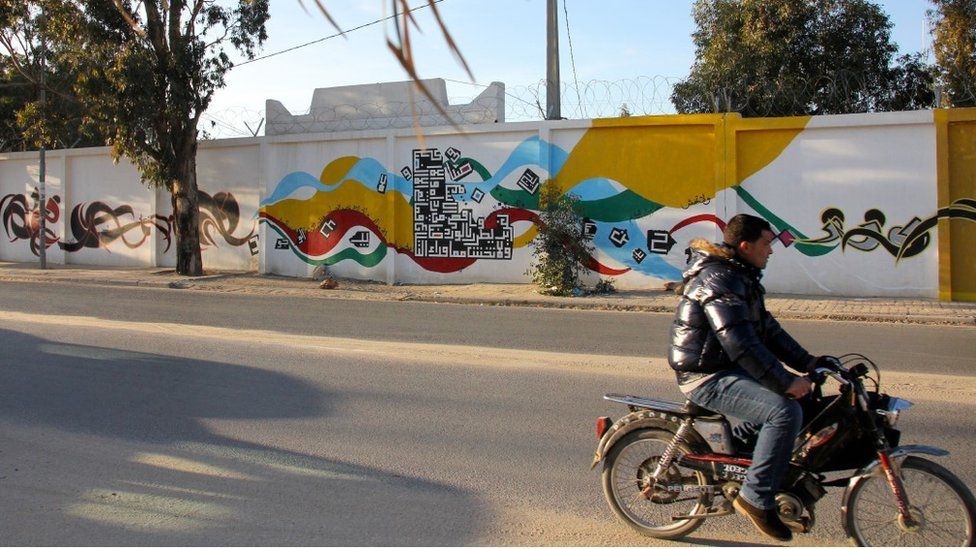In pictures: Mixing graffiti and calligraphy in Tunisia
- Published

Street artists Karim Jabbari is hoping to revive and modernise the ancient art of Arabic calligraphy in Tunisia. He painted this 250 metre (270 yard) graffiti mural onto the wall of a prison in his home town of Kasserine. The playful, ever-changing motifs stand in stark contrast to the barbed wire on the top of the prison wall.
Jabbari, 35, has a signature style that mixes traditional Arabic calligraphy traditions with an edgy, urban aesthetic.
Jabbari's work includes light calligraphy, as pictured here at the Roman amphitheatre in the city of Sbeitla. Light calligraphy is created by using long exposures to capture the movement of a torch with a digital camera. The torch acts like an airbrush, with the public space as a canvas.
He is passionate about engaging young Tunisians in deprived towns like Kasserine, where youth unemployment remains stubbornly high. The street mural was created with young local artists like 19-year-old Saif (left) and 17 year-old Ayoub. “Initially my friends were sceptical,“ says Saif. "But then they joined me, because they liked what we were doing."
Jabbari refers to his technique as "calligraffiti“, a mix of Arabic calligraphy and graffiti. He thinks too many young Tunisian street artists are trying to imitate French and US aesthetics. “The Islamic art scene is new to Tunisia,“ says Jabbari. "My art is deeply rooted in North African history, yet it is urban.“
Included in the artwork is "Yebne Ommi“, a poem by Tunisia's best known poet Aboul Qacem Echebbi. The letters and lines are scattered across the wall. "It's an anthem to enjoy life,“ says Jabbari. "The poem is what makes the mural cohesive, by connecting all the different pieces to one another.“
Jabbari experiments with two of the oldest calligraphy styles: Kufi and Maghribi. Maghribi (above) means “Western” in Arabic and refers to the Islamic world of North Africa and Spain, where this script was developed in the 10th Century. Kufi is even older and dates back to the 7th Century.
Working on a prison wall has a particular resonance for Jabbari. His father Abdallah, an Islamist, opposed the government ousted in the 2011 revolution. The family was persecuted for their political beliefs and tried several times to leave Tunisia. Eventually, Abdallah was jailed. He spent two years behind these very prison walls, now a local landmark. "My father had horrible experiences in prison. It's a part of his life I want to forget. I can't bring myself to talk to him about it," says Jabbari.
For him, learning and practising calligraphy brought a sense of relief. "I didn't have a normal childhood. We didn't have a social life. People were avoiding us on the street," he remembers
The centre piece of the mural captures the spirit behind the project. Jabbari has created a puzzle based on Yebne Ommi. "It talks about the need to get up and strive. Life doesn’t wait for those who choose to sleep,“ he says. "I think it applies to this city and other cities in the Arab world.“